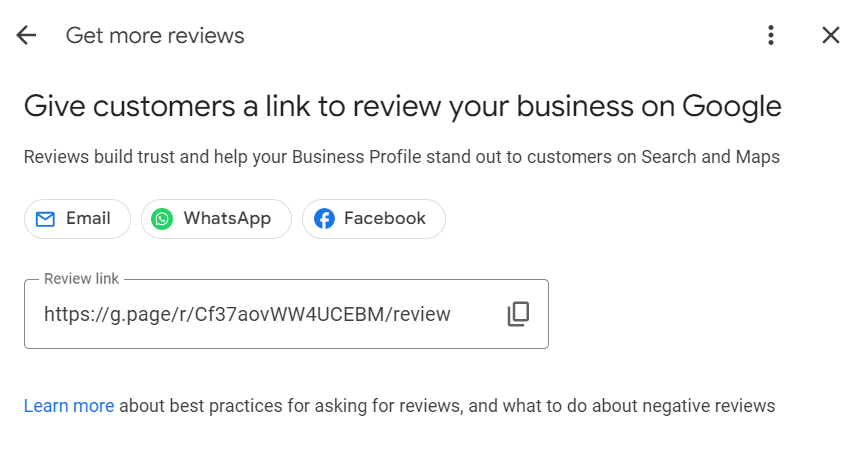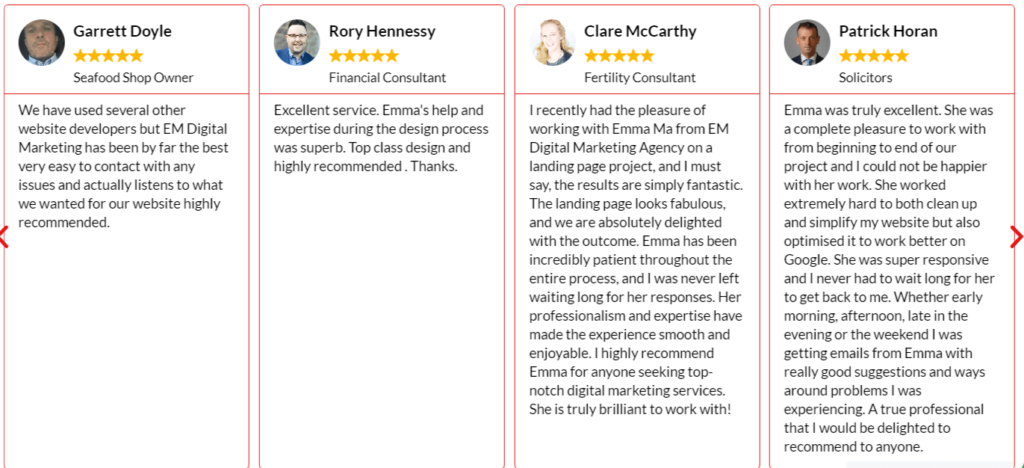
Google reviews is one of the critical aspects of ranking for businesses, including all businesses.
With over 95% of consumers reading other people’s reviews before making a purchasing decision, businesses must realise the impact of Google reviews and use social proof like Google reviews to grow their firm effectively.
Google reviews is part of your Google Business Profile.
Let me tell you everything about Google reviews, explore the benefits, drawbacks, and strategies and show you how to grow your business with Google reviews.
But first, let’s have a look at this Google reviews statistics, just to give you some ideas of the power of Google reviews.
You can see from the image that online reviews influence 89% of people before purchasing.
49% of people believe online reviews are just the same as personal recommendations from a friend or family member.
94% say negative reviews have made them decide to stay away from a business.
97% of people read reviews for local businesses.
Furthermore, Google hosts 73% of all online business reviews, making it a most important social proof for business owners like you to focus on.
Here are some key benefits of having more Google reviews that you should know as a business owner:
Positive Google reviews act as social proof and increase trust and confidence in potential clients.
When clients see a high number of positive reviews, they are more likely to perceive it as reliable, reputable, and credible.
On the flip side, negative reviews can seriously harm your reputation and deter potential clients from engaging with your business.
Apart from influencing consumer behaviour, Google’s search algorithms take into account the quantity and quality of reviews as a local SEO ranking factor.
Local business with more positive reviews will rank significantly higher than competitors, bringing higher visibility and more traffic.
Your Google Business Profile is linked to your Google Maps listing.
When people search for legal services on Google Maps, the more good reviews a business has, the more clients are willing to make the positive decision.
Over 81% of consumers say they are likely to check Google reviews first.
74% of consumers say that reviews increase trust.
This highlights the importance of actively encouraging clients to leave reviews and continuously monitoring and managing your online reputation.

Positive Google reviews can be a game-changer for businesses.
They act as social proof, reinforcing the credibility and trustworthiness.
When potential clients come across a business with many positive reviews, they are more likely to perceive it as reliable and worth their time and money.
Positive reviews generate word-of-mouth marketing, further expanding your business’s reach.
Negative Google reviews can damage a business’s image and deter potential clients’ engagement.
Negative reviews also have the potential to go viral, spreading across social media platforms and causing irreparable damage to a business’s reputation.
Furthermore, negative reviews can lower a business’s local search rankings, making you less visible to potential clients in the local area.
So, businesses must address negative reviews promptly and effectively to limit your impact on the business.
Managing Google reviews effectively requires a proactive approach.
Firstly, it is essential to actively monitor your online presence and promptly respond to both positive and negative reviews. Responding to positive reviews shows appreciation for customer feedback and encourages further engagement.
When it comes to negative reviews, it is crucial to address them with empathy and professionalism.
Acknowledge the client’s concerns, offer solutions, and demonstrate a willingness to rectify the situation.
Businesses can resolve the issue and showcase your commitment to clients satisfaction.
Google reviews provide a treasure trove of clients feedback that businesses can leverage to improve your services, and overall clients experience.
Analysing clients feedback can reveal patterns and trends, highlighting areas of improvement and identifying potential gaps in your offerings.
This valuable feedback can be used to make informed decisions, refine your practice services, and consistently meet and exceed clients’ expectations.
You can continuously improve and drive business growth by actively listening to your clients.

Let’s take a look at a case study that illustrates how a local restaurant successfully utilised Google Map reviews to drive growth.
This restaurant, located in a suburban area, struggled to attract new customers in its local area.
The restaurant owners discovered that many people use Google Maps to find local businesses and that Google Maps displays reviews and ratings for those businesses.
They realised the potential impact of positive reviews on their visibility and credibility. Thus, they decided to focus on improving their Google Map rating as a strategy to attract new customers and compete with larger chains in their area.
The owners encouraged customers to leave reviews after their visit to improve their Google Map rating.
They added signs in the restaurant and included a receipt note asking for feedback. They also offer discounts or free items to customers who leave reviews on future visits.
Soon, they recognised the importance of promptly addressing negative reviews, responding professionally, and offering solutions or apologies. This approach demonstrated their commitment to customer satisfaction and helped improve their overall reputation.
Over time, the restaurant’s Google Map rating significantly improved, with many customers leaving positive feedback about their experience.
As a result, they saw an increase in foot traffic, repeat customers, and online orders through Google Maps and other online platforms. This success story highlights how leveraging Google Map reviews can significantly impact local businesses’ growth.
Now, let me get into some practical tips for businesses to leverage Google Map reviews effectively.

The first and foremost tip is to provide exceptional client service—no doubt about that.
You need excellent client service to help you shape your business’s reputation and attract positive reviews.
A study by McKinsey reveals that 70 per cent of customer experiences are influenced by how they are treated.
If you deliver excellent client service, your business will stand out.
That said, it can encourage your clients to become brand advocates, leaving positive reviews and recommendations.
To provide exceptional client service, you need your team to be on the same page as you. Ensure your employees are well-trained and knowledgeable about Google reviews. They should prioritise client satisfaction and go above and beyond to meet client needs.
By consistently delivering on promises and providing top-notch services, you can create a positive client experience that encourages clients to leave reviews.

One of the simplest and most effective ways to generate Google Map reviews is to ask clients.
Do not forget to train your employees to request client reviews. Make the process simple by providing clear instructions and links for leaving a review.
For example, you can create instruction cards or include links in email signatures, social media profiles, and other marketing materials.
By asking clients directly for reviews, you increase the likelihood of them taking the time to leave feedback.
Personalised requests can make clients feel valued and more willing to share their experiences.
Remember to ask for reviews at the right time, such as after a client has experienced your service, placed a repeat order, tagged you on social media, or spent significant time on your website or app.
Incentivising clients can be an effective way to encourage them to leave reviews.
For instance, offer incentives such as discounts or free consultation for clients who leave a review.
However, ensuring the incentives are transparent and do not create a bias towards positive reviews is essential. Encourage clients to leave honest feedback, whether positive, negative, or neutral.
By providing incentives, you show clients that their opinions are valuable and you appreciate their feedback. This can motivate them to take their time to write a review and share their experiences with others.
Remember to comply with Google review guidelines. To read Google review guidelines for businesses, Click Here or Click the text.

Make it easy for clients to leave reviews on Google Maps.
Provide clear instructions, links, or QR codes that direct customers to your Google Maps listing.
Consider using leave-behind cards, business cards, counter cards, or window clings to remind clients to leave a review.
Additionally, you can include CTAs or pop-ups on your website or app to nudge clients to contribute a positive word.
Simplifying the review process reduces friction and increases the likelihood of clients following through with leaving a review.
The more seamless and convenient the process is, the more likely clients will participate.
Make it a part of your client journey to solicit reviews and take advantage of key touchpoints when clients are most likely to engage.
Your team can play a significant role in collecting reviews for your business.
They interact with clients on a daily basis, addressing queries and resolving issues.
Motivate and train them to ask clients for reviews during their interactions. Provide them with scripts or examples of politely and sincerely inviting reviews.
On top of that, consider implementing an incentive system to reward admin members based on the number of reviews they secure.
Motivate them to ask for reviews as a regular part of their routine. Recognise and reward employees mentioned in reviews, which signifies that they have exceeded clients expectations.
Make it easy for clients to find and access your Google reviews by creating custom links on your website or app.
Avoid simply pasting reviews on your site, as this can raise questions about authenticity.
Instead, add a graphic or button on your page that says “Read our Google reviews” and link it using your Places ID.
Provide your clients with a direct link to your Google reviews so they can quickly access feedback from others and make informed decisions. This not only enhances your online reputation but also builds trust and credibility.
Custom links can be integrated seamlessly into your website or app design, making it effortless for clients to navigate the reviews section.
Respond to all your clients’ reviews, whether positive or negative.
Take your time to respond to all reviews promptly and professionally.
Express your gratitude to clients who left you a positive review.
This reinforces the positive experience and encourages clients to continue supporting your business.
For negative reviews, approach them with empathy and a willingness to resolve the issue.
Apologise to clients for any negative experiences and offer to connect offline to address their concerns further.
I have a list of strategies for dealing with negative reviews in the below section. Continue reading…
When asking clients to leave reviews, highlight the benefits they will receive.
Explain how their reviews will be used to improve your services and overall client experience.
Use powerful phrases that put clients in a position of being a beneficiary, making them feel rewarded for their contribution.
By addressing the “What’s in it for me?” aspect, you create a sense of value and purpose for clients to take the time to write a review.
Show them their feedback matters and will directly impact their future experiences with your business.
Make it clear that their voices are heard and that their reviews make a difference.
Hosting experiential events can create a strong bond between your clients and your business, leading them to leave positive reviews.
Experiential marketing focuses on creating memorable experiences that allow clients to connect with your business’s core values.
By immersing clients in unique experiences, you encourage them to share their experiences through reviews.
Consider hosting online webinar, industry events, or interactive workshops that allow clients to engage with your business on a deeper level.
These events can create a sense of excitement and community, leading attendees to share their experiences through reviews.
By offering unique and valuable experiences, you provide clients with content to write about and share with others.
Ask your clients to leave a review after won the case for them; it is the simplest and most direct way to get good reviews.
While this may seem obvious, many businesses overlook this crucial step.
Reach out to your satisfied clients and kindly request them to leave a review on Google maps.
Personalise your request and express gratitude for their support.
Remember to respond promptly to the reviews you receive, showing your appreciation and engagement with your clients.
Google provides a free Marketing Kit for businesses with a verified Google Business Profile.
This kit includes digital and printable materials that can help you promote your business and encourage more Google reviews.
You can use the provided tools, such as posters of your business storefront, and business cards with QR codes that lead directly to your reviews page, to make it easier for clients to leave reviews.
Using QR codes correctly can be a game-changer for getting more Google reviews.
Link your QR code directly to your Google reviews page and incorporate it into your marketing materials, both online and offline.
Add QR codes to your website, email newsletters, social media profiles, and physical materials like business cards.
This makes it convenient for clients to access your reviews page and leave a review with just a scan.

Sending personalised thank-you notes to your clients shows appreciation and allows you to request Google reviews.
Include a brief message in your thank-you notes, expressing gratitude for their support and kindly asking them to share their experience by leaving a review on Google.
You can include a shortened link or QR code to make the review process easier for them.
Add in a polite request for a Google review on your receipts, whether printed, emailed, or SMS.
Including a shortened link or QR code makes it convenient for clients to leave feedback immediately after their purchase.
Timing is crucial when asking for reviews.
Set up automated transactional emails to clients after a specific period.
What you put in the email is kindly asking them to write a review, and do not forget to leave your Google review page link.
Showcase your positive Google reviews on your social media platforms.
Share screenshots or excerpts of your best reviews on platforms like Facebook, Instagram, LinkedIn, and Twitter.
This promotes your business and encourages other clients to leave their reviews.
Include a call-to-action in your posts, ask your followers to leave a review and share their experiences.
Respond to your client reviews as soon as possible, and show them that you care and appreciate their time.
Respond to bad reviews with a positive attitude, address issues and try to resolve them as best as you can. It shows your clients that you are committed to client satisfaction and can turn negative experiences into positive ones.

Integrating Google reviews directly onto your website can influence client trust and engagement.
Embedding reviews allows potential client to see honest feedback from previous clients, boosting their confidence in you.
It also provides fresh and updated content for your website, benefiting your SEO efforts.
Use widgets or plugins to display your Google reviews on your website quickly and encourage visitors to leave their reviews.
Traditional marketing still exists and works.
Brochures, business cards, and posters present an opportunity to promote your Google reviews.
Include a call-to-action with a QR code or shortened link, encouraging clients to leave a review.
Using traditional marketing as part of your marketing strategy enables you to reach more potential clients and receive more reviews.
Following Google review policies in your practice is essential, as you do not want to get punished by Google. That is the last thing you want to do.
But you can still offer incentives to clients within the guidelines. For example, you can offer free consultation, or a small discount if they refer more clients to you.
Ensure to communicate clearly that the incentive is to leave an honest review rather than write a positive one.
Monitoring and managing your online reputation is crucial to gather more Google reviews.
Regularly check your Google Business Profile for new reviews and respond promptly.
Engage with your clients, address concerns, and show that you value their feedback.
Utilise online reputation management tools to streamline the process and ensure you stay on top of your business’s online presence.
Encouraging clients to leave positive reviews requires a proactive approach.
Firstly, provide exceptional client services that exceed their expectations.
Secondly, make it easy for them to leave reviews by giving clear instructions and links on your website or social media platforms.
Consider incentivising clients with discounts or rewards for leaving reviews.
Lastly, engage with your clients and build relationships.
By fostering a strong connection with your client base, you increase the likelihood of them becoming brand advocates and leaving positive reviews.
When faced with a negative review, it’s important not to panic or lash out.
Instead, take a deep breath and evaluate the situation objectively.
The statistic shows that one negative review can cost up to 30 new customers. So, knowing how to respond to a negative review without costing a fortune is very important.
Analyse if the review is genuine, misrepresentation, misinformation, or even a deliberate attempt to damage your reputation.
If the review is honest, look into the client’s experience, including their purchase history and interactions with your admin team.
The more you understand the situation, the better equipped you’ll be to handle it.
Regardless of the review’s authenticity, it’s important to respond promptly.
According to Google review statistics, 53% of customers expect respond to negative reviews within a week. However, 63% say they have never received a response to their review.
Not responding to a negative review is wrong and can damage your reputation.
So, how to actually respond to a negative review? Here are a few best practices:
1. When responding to a negative review, remain professional and empathetic.
2. Apologise to the reviewer for his/her dissatisfaction with your service.
3. Address the concerns raised seriously with the reviewer.
4. Take responsibility and explain to the viewer that this won’t happen again.
4. Talk to the reviewer with patience and active listening to what had made the reviewer very unsatisfied.
5. Offer a solution to the reviewer.
6. Take this opportunity to turn things around and ensure the reviewer is satisfied with your response.
7. Appreciate the reviewer’s feedback and mention to the reviewer to update the negative review.
Unfortunately, fake or malicious reviews are unfortunate in the digital world.
These reviews can damage a business’ reputation and be challenging to combat.
However, there are steps businesses can take to mitigate their impact.
Firstly, flag the review as inappropriate to bring it to Google’s attention. Provide evidence and explain why you believe the review is fake or malicious.
Google usually investigates issues and takes appropriate action if necessary.
Secondly, respond to the review professionally, addressing the concerns raised and providing accurate information.
By doing so, you demonstrate your commitment to transparency and authenticity.
Fake reviews can be highly damaging to businesses’ reputation. Fortunately, Google allows you to flag reviews that violate its policies. To remove a fake Google review, follow these steps:
Keep in mind that the process of removing a flagged review may take time.
Google typically intervenes within 2 to 4 weeks, although it can sometimes take longer.
Occasionally, Google may request additional information or evidence to support your claim.
Suppose the review involves slander or false statements. In that case, you can also explore legal options by filling out a Google form for a lawful removal request.
Addressing negative reviews goes beyond simply removing or responding to them.
Take proactive steps to rectify the underlying issues and improve overall client satisfaction.
Consider re-evaluating your processes, client service training, or service quality if there are recurring complaints.

Managing your online reputation requires ongoing effort.
Stay on top of the situation, even after addressing negative reviews.
Continuously monitor your online reviews and respond promptly to any new feedback, positive or negative.
Acknowledging and addressing client concerns helps to build trust and can even lead reviewers to update their negative feedback to positive.
If you find a review that violates Google’s policies but has yet to be removed after flagging, You can contact Google Small Business support for assistance.
Contact them through the support page on the Google My Business platform, and they should respond within 24 hours.
While removing fake reviews and responding to negative ones is essential to a business, you should also implement additional strategies to manage your online reputation effectively.
Here are some recommended approaches:
Encourage Positive Reviews: Always encourage your client to leave a positive review on Google. This helps counterbalance any negative feedback and boosts your overall rating.
Address Concerns Offline: Take conversations with dissatisfied clients offline. Offer to discuss their concerns privately through email or direct messaging. This allows you to address their issues more personally and effectively.
Monitor and Respond on Multiple Platforms: It’s not just Google reviews that matter. Keep an eye on other review sites like Yelp and Trustpilot. Respond promptly to reviews on all platforms to demonstrate your commitment to customer satisfaction.
Seek Professional Help: If managing your online reputation becomes overwhelming, consider partnering with a reputable online reputation management company. These professionals can help monitor and protect your brand’s reputation across various platforms.
Managing bad Google reviews and maintaining a positive online reputation is crucial for businesses. You can effectively manage your online presence by evaluating and responding to negative reviews, flagging and removing fake ones, rectifying underlying issues, monitoring your online reputation, and implementing additional strategies. Client satisfaction should be at the forefront of your efforts, as it significantly shapes a business’s success.
Acquiring positive Google reviews will help businesses build a solid online reputation.
By understanding the impact of Google reviews and implementing effective strategies consistently to manage and leverage them, businesses can drive customer engagement, increase online visibility, and ultimately increase business revenue.
Begin to implement some of the strategies I mentioned in this article. Do not be shy about asking your clients for a good review after serving them a good-quality service.
If you still have questions, please email or call me today to learn how I can help businesses optimise their online reputation and leverage the power of Google reviews for businesses.
2025 @EM Digital Marketing Ltd.
All rights reserved.
Company Number: 752077 Ireland